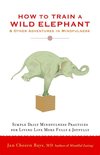
How to Train a Wild Elephant

When eating, just eat. When drinking, just drink. Mindfulness is the very best seasoning, for your food and for your entire life. Enjoy each bite, enjoy each moment!
Jan Chozen Bays • How to Train a Wild Elephant
This week, when you’re eating or drinking, don’t do anything else. Sit down and take the time to enjoy what you are taking in. Open all the senses as you eat or drink. Look at the colors, shapes, surface textures. Attend to the smells and flavors in your mouth. Listen to the sounds of eating and drinking.
Reminding yourself
Post a note on the table
... See moreJan Chozen Bays • How to Train a Wild Elephant
Anxiety is the subtle and pervasive destroyer of our happiness. It depends upon thoughts of past and future. It cannot exist in the present.